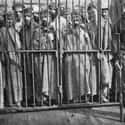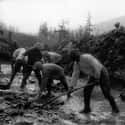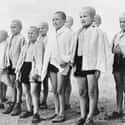-
(#4) Inmates Killed One Another Over Food And Shoes
Soviet society - and Stalin himself - considered Gulag prisoners, regardless of background or lack of guilt, as cogs in the great machine of socialist advancement towards communism. Known as "zeks," a Russian slang term for prisoners, the inmates were considered valueless and treated a such.
While interned, prisoners were issued rations that included rudimentary clothing, the occasional eating utensil, and scant amounts of low-protein food. This, combined with the long hours of labor, caused inmates to be simultaneously starved and worked to death along with suffering from disease and exposure.
Fights broke out over food, and some prisoners became hoarders of basic items. Tobacco, food, sewing needles, and even shoes and sweaters were traded within a strict and lethal inmate hierarchy. Protection was bought, gambling occurred, debts were paid, and prisoners took each other's lives over simple sundries. Within the camp administration, food was used as both an incentive to work harder and as a weapon.
-
(#6) Canals Were Built Over The Bodies Of Prisoners
The shadow of the Gulag can be felt today by tourists traveling on ferries down the Moscow-Volga and White Sea-Baltic Canals. Underneath their tranquil facades lies a heartbreaking example of how Gulag prisoners were really treated.
Adding to the frenzied collectivization of Russia, Stalin formulated plans for direct shipping and the navy, which required that two canals be built, running north to south. To accomplish this feat, huge amounts of labor were required over a short time period.
From 1931 to 1933, thousands of prisoners were brought to the construction areas. They dug, mostly by hand, a 30-mile long addition to the White Sea-Baltic Canal, losing around an estimated 12,000 lives in the process. The actual figure is likely higher. A few years later, from 1933 until 1937, the same project began for the Moscow-Volga Canal on the Volga River. This canal was 80 miles long with eight locks, and it was just as dangerous to excavate. In the White Sea-Baltic building project, workers who perished on the job were disposed of by being dumped into a mass grave and buried in the soil of the canal before it was flooded over.
-
(#12) Some Survivors Are Still Afraid To Discuss Their Imprisonment
On paper, the Gulag was a prison camp administration, but in practice, the arrests, reasons for incarceration, hard labor, separation from family, executions, and weather all grimly exceeded this simple, bureaucratic designation. They gave this system of "administration" its notorious legacy.
When Stalin passed in 1953, the Gulag held more than 3 million prisoners. Within days of his passing, millions of prisoners had been released, and the new premier, Nikita Sergeyevich Khruschev, began a process of de-Stalinization known as the "thaw."
With Stalin gone, the reality that the camp system was immoral and economically useless led to a period of shrinkage and mass releases of prisoners, many of whom were rehabilitated. However, the trauma it inflicted on its inmates both physically and mentally, from 1918 until Stalin’s passing, left scars on several generations of Russians. Some have survived to this day but are still extremely fearful of discussing their experiences.
-
(#13) If You Wanted To Escape, You Had To Go To Finland Or China
Escape from the Gulag was no easy feat. Not only did you have to make it past guards and Gulag gangs, but you also had to trek through harsh climates to countries that wouldn't extradite you. There were only two of those: Finland and China. However, a few notable individuals did escape. One story, about a Polish army officer who escaped and crossed the Himalayas to India on foot was made into a film, The Way Back. However, the veracity of this story is disputed.
A verifiable escape did occur in 1933 when Vladimir Tchernavin, his wife Tatiana, and their son Andrei managed to slip away out of Russia and take refuge in Finland. After brief incarceration, Tchernavin was transferred to Karelia near the Finnish border because of his fisheries knowledge. While there, Tchernavin met a local peasant who explained that the camp guards had "a beat of 15 kilometers and they patrol it in pairs. When two return two others start out. Mostly they lie around and listen to the radio. They don’t like to go in the woods. They’re afraid. It is said that there are escaped convicts there who will lie in wait for them and kill them." With this useful insight, Tchernavin began contemplating escape.
In 1931, because of good behavior, Tchernavin’s wife and son were allowed to visit him. Immediately he and Tatiana put escape plans into motion using written code in letters to each other. Towards the end of the summer in 1933, the Tchernavin family were able to slip away from the Gulag camp guards during a visit. On foot and by a boat hidden prior to escape, they fled to Finland. According to Tchernavin, they crossed rivers, forests, and mountains with few provisions, camping in the wilderness to avoid detection.
All three survived, and once they were safe in Finland, they emigrated to England.
-
(#5) The Gulag Was A Slave Labor Front
During interrogation, anyone who was arrested was often given bogus reasons for their arrest. These absurd reasons included the usual list of treasonous acts like spying, economic sabotage, anti-revolutionary activity, or - after the 1930s - being sympathetic to enemies of the state such as the Kulaks. While these were some of the reasons given, they masked the true reason that many people were arrested: their economic value.
After Joseph Stalin initiated his five-year plan to rapidly modernize the Soviet Union, the government needed laborers to work on huge construction and industrial projects. It also quickly realized that there was a lack of knowledgeable and skilled specialists. So a steady stream of arrests and the deportation of hundreds, then thousands, of people year after year fed the Gulag, which then, with the aid of its slave labor, built Stalinist Russia.
Gulag camp guards had control over every aspect of a prisoner's existence. If a guard was in a good mood or bad mood, that could determine how much a prisoner ate, what clothes they could wear, and where they slept.
-
(#7) Children and Infants Were Incarcerated In the Camps
During the Russian Civil War, around 800,000 soldiers and approximately 8 million civilians perished from war and famine.
As a result, it is believed that following the Civil War in the '20s and '30s, there were around 7 million homeless children and youths throughout the Soviet Union who had lost parents during the conflict. Many were forced to resort to crime to survive and were picked up and sent to the Gulag as a result.
And it wasn't just already existing children who were brought to the Gulag - some were born there, too. Women who gave birth in the Gulag were kept with their children until the child was 2. Poor sanitary conditions, lack of nutrition, neglect, and nonexistent basic necessities were all things new mothers had to face with their infants. As a result, many newborns perished early on, and the lack of food caused many children to be physically and mentally underdeveloped for life.
New Random Displays Display All By Ranking
About This Tool
Gulag Prison is the most notorious prison system in Soviet history. Prisoners were beaten and tortured there, but some survived. This nauseating and cruel forced labor system was first established after the Russian Civil War. By the 1950s, the labor camps had covered the entire Soviet territory, it can be said one of the darkest periods in the history of the 20th century.
In the Gulag camp, the prisoners did not have safety guarantees or equipment to complete their tasks. They even excavate or build complex projects in cold Siberia only with winter clothes and original tools. It is not surprising that people always die from fatigue and cold. The random tool lists 13 facts about life in Soviet Gulag.
Our data comes from Ranker, If you want to participate in the ranking of items displayed on this page, please click here.
















